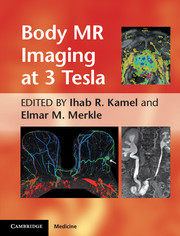Book contents
- Frontmatter
- Contents
- Contributors
- Foreword
- Preface
- Chapter 1 Body MR imaging at 3T: basic considerations about artifacts and safety
- Chapter 2 Novel acquisition techniques that are facilitated by 3T
- Chapter 3 Breast MR imaging
- Chapter 4 Cardiac MR imaging
- Chapter 5 Abdominal and pelvic MR angiography
- Chapter 6 Liver MR imaging at 3T: challenges and opportunities
- Chapter 7 MR imaging of the pancreas
- Chapter 8 MR imaging of the adrenal glands
- Chapter 9 Magnetic resonance cholangiopancreatography
- Chapter 10 MR imaging of small and large bowel
- Chapter 11 MR imaging of the rectum, 3T vs. 1.5T
- Chapter 12 Imaging of the kidneys and MR urography at 3T
- Chapter 13 MR imaging and MR-guided biopsy of the prostate at 3T
- Chapter 14 Female pelvic imaging at 3T
- Index
- Plate section
- References
Chapter 1 - Body MR imaging at 3T: basic considerations about artifacts and safety
Published online by Cambridge University Press: 05 August 2011
- Frontmatter
- Contents
- Contributors
- Foreword
- Preface
- Chapter 1 Body MR imaging at 3T: basic considerations about artifacts and safety
- Chapter 2 Novel acquisition techniques that are facilitated by 3T
- Chapter 3 Breast MR imaging
- Chapter 4 Cardiac MR imaging
- Chapter 5 Abdominal and pelvic MR angiography
- Chapter 6 Liver MR imaging at 3T: challenges and opportunities
- Chapter 7 MR imaging of the pancreas
- Chapter 8 MR imaging of the adrenal glands
- Chapter 9 Magnetic resonance cholangiopancreatography
- Chapter 10 MR imaging of small and large bowel
- Chapter 11 MR imaging of the rectum, 3T vs. 1.5T
- Chapter 12 Imaging of the kidneys and MR urography at 3T
- Chapter 13 MR imaging and MR-guided biopsy of the prostate at 3T
- Chapter 14 Female pelvic imaging at 3T
- Index
- Plate section
- References
Summary
Introduction
Three Tesla magnetic resonance (MR) imaging scanners have been seeing steadily increasing use recently as hardware has matured and pulse sequences have become more optimized for a higher field strength. This increase in popularity has been more pronounced for neurologic and musculoskeletal imaging than for body imaging, however, due to the fact that 3T imaging with the larger field of view required for the torso tends to be more susceptible to artifacts and energy absorption limits than the imaging of smaller body parts.
Imaging artifacts at 3T tend to be more numerous and/or more pronounced than at lower field strengths. While most of these artifacts are the same ones encountered at lower field strengths (e.g., flow artifacts, motion artifacts, Gibbs ringing), many are more peculiar to high-field imaging. This chapter will discuss these field strength-related artifacts at 3T as they apply to body imaging with specific comparisons made to 1.5T. The differences in relaxation times, chemical shift effects, and issues related to field inhomogeneity will also be discussed. Various approaches to mitigating artifacts peculiar to an increase in field strength at 3T will also be addressed.
- Type
- Chapter
- Information
- Body MR Imaging at 3 Tesla , pp. 1 - 11Publisher: Cambridge University PressPrint publication year: 2011
References
- 1
- Cited by



